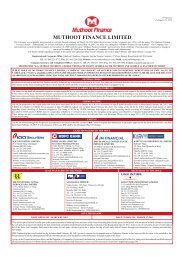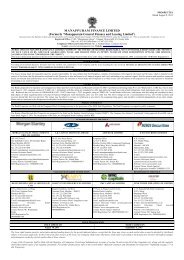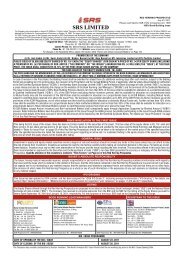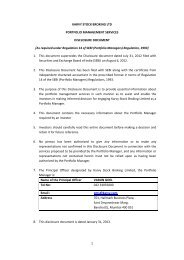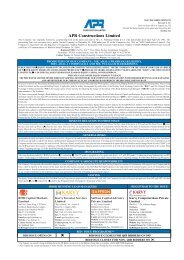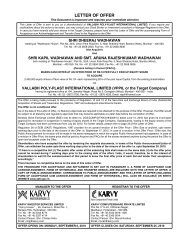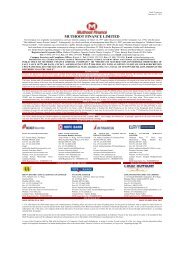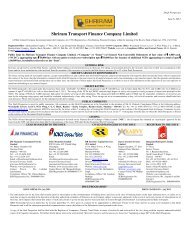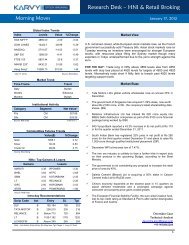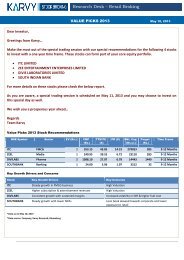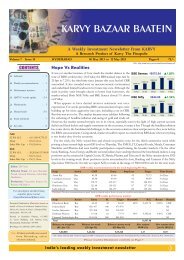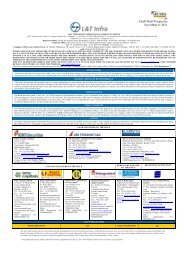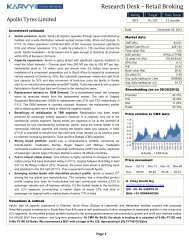Shriram City Union Finance Limited - Karvy
Shriram City Union Finance Limited - Karvy
Shriram City Union Finance Limited - Karvy
- No tags were found...
You also want an ePaper? Increase the reach of your titles
YUMPU automatically turns print PDFs into web optimized ePapers that Google loves.
Overall demand drivers for the passenger cars industry [Source: CRISIL – Retail <strong>Finance</strong> – Auto – May 2011]1. Increase in affordability: Growth in passenger car sales is mainly driven by greater affordability, whichenhances the aspiration levels of the consumers. The following factors determine affordability:2. Growth in addressable market, led by increase in disposable income: Addressable households in Indiatrebled during 2003-04 to 2008-09, led by an increase in per capita income. During 2003-04 to 2007-08,there was a huge increase in the addressable market due to higher affordability, led by rise in per capitaincome. However, in 2008-09, the size of the addressable market rose on account of a decline in car prices,which was in turn the result of a reduction in excise duty on small cars from 16 % to 8 %.Over the next 5 years, increase in per capita income and a reduction in entry-level prices of cars will be themajor drivers for the increase in affordability. A fall in car prices due to a rise in competition in the smallcar segment, with the launch of ultra low-cost cars are likely to substantially increase the addressablemarket in 2009-10.3. New launches: There is a significant increase in car sales after the launch of new models, as customers aretempted to prepone their decision to purchase the vehicle. With competition intensifying, the number ofnew launches has gone up, which will continue to drive demand. New launches at competitive prices acrosssegments, which are less penetrated, would also woo customers for new purchases.4. Increase in dealerships and easy access to finance: The widening of distribution networks by automakerswill push up car sales, as a large number of households will be added to the target population. Typically,these households have the potential to buy a car, but defer the decision due to lack of sales and serviceinfrastructure. With most urban centres covered by dealership networks, car manufacturers are setting upnew dealerships in smaller towns to increase penetration and sales in semi-urban and rural areas. Enhancedpenetration of financing will also help the rise in passenger car sales across all segments. Mostmanufacturers are targeting rural and semi-urban areas to increase sales volumes due to the rise indisposable incomes in these areas. Along with increasing the number of dealerships, manufacturers areproviding easy accessibility to finance in these markets to enable customers to purchase cars.5. Reduction in excise duty: A cut in excise duty on cars, which if passed on by original equipmentmanufacturers, increases affordability for buyers. In December 2008, excise duty on small cars (cars thatare less than 4,000 mm long and have an engine capacity below 1,200 cc and 1,500 cc for petrol cars anddiesel cars, respectively) was cut to 8 % from 12 %. For other cars and UVs, the duty was reduced to 20 %from 24 %. The decline in small-car prices led to increase in demand on account of the lower cost ofownership and growth in the addressable market.6. Reduction in holding period increases demand for a second car: A decline in the average holding periodwill also increase passenger car sales, mainly in the mainstream/ small car/ mid-size segments. The averageholding period has shrunk to 3-4 years in 2008-09 from 5-6 years in 2000-01, implying frequentupgradations to advanced models from the same or higher segment. Also, the concept of a second car is onthe rise in urban areas. With more than one working member in a family, the need for personaltransportation is an impetus for purchasing more than one car.Commercial Vehicles IndustryThe commercial vehicle industry is segmented into “light commercial vehicles” (for vehicles with gross vehicleweight of less than 7.5 tons) and “medium and heavy commercial vehicles” (for vehicles weighing more than 7.5tons). The performance of the medium and heavy commercial vehicle industry bears a high correlation withindustrial growth and is driven by economic development, improved road infrastructure (such as the GoldenQuadrilateral) for long haulage transportation and a favorable regulatory environment (in this regard, demandcreated in the years 2006-2007 was attributable to the strict enforcement of overloading restrictions and age norms).In turn, the performance of the light commercial vehicle industry tends to be less cyclical in nature and is driven byGDP growth and demand for last mile distribution. The market share of light commercial vehicles increased rapidly- the introduction of a sub-one ton carrier by certain players created a new segment typically occupied by three-68



